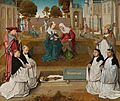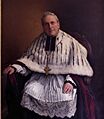Canon (title) facts for kids
A Canon is a special title given to certain members of the Christian clergy, especially in the Catholic Church and the Church of England. It usually refers to a priest or other religious person who follows specific church rules or traditions.
Originally, a canon was a cleric (a religious leader) who lived with other clergy in a special house near a large church or cathedral. They lived by a set of rules, which became common around the 8th century AD. Later, in the 11th century, some churches asked these clergy to follow a rule from Saint Augustine. This rule meant they had to give up their personal wealth. Those who followed this new rule were called Canons Regular, or Augustinians. Those who did not were known as secular canons.
Contents
Secular Canons: Church Leaders in Cathedrals
Catholic Church Canons
In the Latin Church (the largest part of the Catholic Church), canons are members of a group called a "chapter." This chapter helps run a cathedral or a collegiate church. A collegiate church is a church that has a chapter of canons, but isn't a cathedral.
One important job of the cathedral chapter used to be choosing a temporary leader for the diocese (a church area) when the bishop was away or when the position was empty. Now, this job usually belongs to a group of consultors, unless the local bishops decide the cathedral chapter should do it.
Church of England Canons
Since the English Reformation, all canons in the Church of England are considered "secular." This means they don't belong to a religious order that lives separately, even though some individual canons might. Most canons are ordained priests or other clergy.
Today, the title of canon is mostly used for people working at cathedral churches. A canon is part of the chapter of priests, led by a dean. This group is in charge of running the cathedral. The dean and chapter are the official body that manages the cathedral and helps elect the bishop.
Honorary Canons: A Special Title
The title of Canon is not always permanent. It is often dropped when a cleric leaves the position that gave them the title. However, many dioceses give the title of "Honorary Canon" to experienced parish priests. This is often a way to recognize their long and dedicated service to the church.
Honorary canons are part of the chapter in name, but they don't live at the cathedral or get paid for this title. They can still call themselves "canon" and might help with the cathedral's administration.
In Anglican churches, canons are usually either "residentiary" (they work at the cathedral) or "honorary" (they are non-cathedral clergy given the title as an honor). Both types might wear a purple or purple-trimmed cassock (a long robe). In some Church of England areas, the title Prebendary is used instead of canon for clergy involved with a cathedral.
Some canons work for the bishop directly, not just the cathedral. For example, in the Episcopal Church (United States), a "Canon to the Ordinary" is a senior priest who works closely with the bishop.
The Catholic Church still appoints honorary canons today. Also, priests of the Sovereign Military Order of Malta and the Equestrian Order of the Holy Sepulchre are honorary canons of these orders. They can use the title "Canon" and "Monsignor" and wear special clothes.
Lay Canons: Non-Clergy Canons
Sometimes, people who are not ordained clergy can also be appointed as canons in Anglican churches. These are called "lay canons." This title is often given to diocesan chancellors, who are the main legal officers of a diocese and are usually not clergy.
For a long time, people thought the British Sovereign (the King or Queen) was a canon of St David's Cathedral in Wales. However, this is a misunderstanding. A specific canonry (a position for a canon) became property of the Crown when monasteries were closed. The Sovereign was never actually a canon, even as a lay person. But the monarch can use a special seat in the cathedral.
Canon Professors: Teachers and Canons
A canon professor is someone who is both a canon at an Anglican cathedral and a university professor. For example, there are four canon professorships at the University of Oxford connected to Christ Church Cathedral, Oxford. There are also two at Durham University linked to Durham Cathedral.
In the past, some of these professorships could only be held by Anglican priests. However, rules have changed. For instance, at Oxford, the position of Regius Professor of Ecclesiastical History was once only for an Anglican priest. But since 1997, it has been held by lay people (non-clergy), including a Catholic layman and a woman.
At Durham, the Van Mildert Professor of Divinity must be an Anglican priest. The Michael Ramsey Professor of Anglican Studies must be Anglican but does not have to be ordained.
Minor Canons: Daily Service Leaders
Minor canons are clergy who are part of a cathedral or collegiate church. Their main job is to lead the daily church services. In some places, like St Paul's Cathedral in London, they have been a separate group.
In St Patrick's Cathedral, Dublin, minor canons are different from, and rank higher than, the Vicars Choral. The two senior vicars are also the two senior Minor Canons. While minor canons sit with the Chapter, they usually don't have voting rights. Today, minor canons are often more junior clergy, but in the past, these positions were held by very distinguished and senior clergy.
Canons Regular: Living in Community
Canons regular are members of certain religious orders in the Catholic Church. They are priests and some choir canons who live together in a community, often with lay brothers. They are different from "clerics regular." There are many groups of canons regular, and some are part of the Confederation of Canons Regular of St. Augustine.
Some examples of Canons Regular orders include:
- The Canons Regular of the Lateran, dating back to the 11th century.
- The Order of the Canons Regular of Premontre, also known as Norbertines, founded by St. Norbert in 1120.
- The Order of the Holy Cross (Canons Regular), founded in Portugal in 1131.
- The Canons Regular of the Order of the Holy Cross (the Crosiers), founded in Belgium in 1211.
- The Swiss Congregation of Canons Regular of Saint Maurice of Agaune.
- The Gilbertine Order, an English order that no longer exists.
- The Canons Regular of the Immaculate Conception, founded in France in 1871.
- The Canons Regular of St. John Cantius, founded in 1998.
Many bishops tried to live a common life with the clergy of their church, similar to St. Augustine. Rules were created for them, like the famous one by St. Chrodegang, Bishop of Metz (766). Over time, this practice declined, and canons started living separately. However, some resisted this change and chose to live together and give up personal wealth. This is how the canons regular began.
Canons regular combine being ordained priests with living a religious life. They are connected to a church and focus on improving divine worship. For monks, being ordained is secondary to their religious life. But for canons, like other clerks regular, being ordained is the main focus, and the religious life is added to that.
Images for kids
-
Another Flemish canon in official clerical dress of canons
-
Canons, Bruges, Belgium
-
Gdańsk, Canons Cross by Giennadij Jerszow
See also
 In Spanish: Canónigo para niños
In Spanish: Canónigo para niños
- Canoness
- Diocesan priest
- Index of religious honorifics and titles







